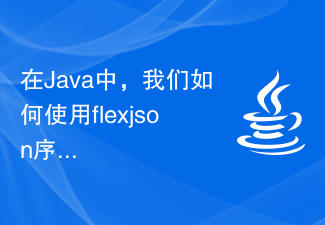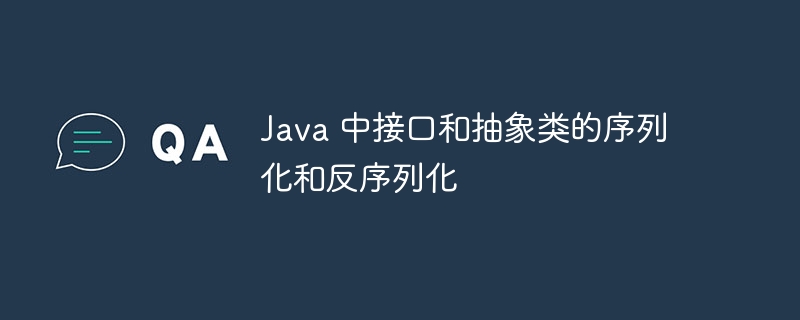Golang serialization methods include: 1. Use the Gob package to manage the gob stream. Gob is bound to the type. If it is found that there is more or less, it will be filled or truncated according to the order. 2. Using the json package, you can implement JSON encoding and decoding defined in RFC 7159; during the serialization process, if the members in the structure are lowercase, an error will occur. 3. Using the Binary package, simple conversion between numbers and byte sequences and encoding and decoding of varint can be achieved. 4. Use protobuf protocol.

The operating environment of this tutorial: Windows 7 system, GO version 1.18, Dell G3 computer.
In the programming process, we always encounter the problem of transmitting our data objects over the network or saving them to files, which requires encoding and decoding actions.
There are currently many encoding formats: json, XML, Gob, Google Protocol Buffer, etc. In Go language, how to encode and decode data in this way?
Serialization and deserialization definition
Serialization (Serialization) is to convert the state information of an object into a form that can be stored or transmitted the process of. During serialization, an object writes its current state to temporary or persistent storage.
In turn, re-reading the variable from the storage area and re-creating the object is deserialization.
In the Go language, the encoding package is specifically designed to handle this type of serialization encoding and decoding issues.
Serialization method – Gob
gob Package management gob stream – encoder (sender) and decoder The binary value exchanged between (receivers). A typical use is to transport parameters and results of remote procedure calls (RPCs), such as the gobs stream used in the "net/rpc" package.
For details, please refer to the documentation: https://docs.studygolang.com/pkg/encoding/gob/
His official website gives an example:
package main
import (
"bytes"
"encoding/gob"
"fmt"
"log"
)
type P struct {
X, Y, Z int
Name string
}
type Q struct {
X, Y *int32
Name string
}
// This example shows the basic usage of the package: Create an encoder,
// transmit some values, receive them with a decoder.
func main() {
// Initialize the encoder and decoder. Normally enc and dec would be
// bound to network connections and the encoder and decoder would
// run in different processes.
var network bytes.Buffer // Stand-in for a network connection //Buffer是具有Read和Write方法的可变大小的字节缓冲区。
enc := gob.NewEncoder(&network) // Will write to network.
dec := gob.NewDecoder(&network) // Will read from network.
// Encode (send) some values.
err := enc.Encode(P{3, 4, 5, "Pythagoras"})
if err != nil {
log.Fatal("encode error:", err)
}
err = enc.Encode(P{1782, 1841, 1922, "Treehouse"})
if err != nil {
log.Fatal("encode error:", err)
}
// Decode (receive) and print the values.
var q Q
err = dec.Decode(&q)
if err != nil {
log.Fatal("decode error 1:", err)
}
fmt.Printf("%q: {%d, %d}\n", q.Name, *q.X, *q.Y)
err = dec.Decode(&q)
if err != nil {
log.Fatal("decode error 2:", err)
}
fmt.Printf("%q: {%d, %d}\n", q.Name, *q.X, *q.Y)
}Run The result is:
"Pythagoras": {3, 4}
"Treehouse": {1782, 1841} Personally, I think this example is really good. We see that structures P and Q are different. We see that Q is missing a Z variable.
However, it can still be parsed when decoding. This shows that when using gob, it is bound according to the type. If it is found that there is more or less, it will be based on the order. Pad or truncate.
Next, let’s talk about how to encode in detail:
1. bytes.Buffer Type
First, we need to define a bytes.Buffer type to accept the structure that needs to be serialized. This type is like this:
// A Buffer is a variable-sized buffer of bytes with Read and Write methods.(Buffer是具有Read和Write方法的可变大小的字节缓冲区)
// The zero value for Buffer is an empty buffer ready to use.
type Buffer struct {
buf []byte // contents are the bytes buf[off : len(buf)]
off int // read at &buf[off], write at &buf[len(buf)]
lastRead readOp // last read operation, so that Unread* can work correctly.
}Using the above example, you can see The output is:
"Pythagoras": {3, 4} ==>
{[42 255 129 3 1 1 1 80 1 255 130 0 1 4 1 1 88 1 4 0 1 1 89 1 4 0 1 1 90 1 4 0 1 4 78 97 109 101 1 12 0 0 0 21 255 130 1 6 1 8 1 10 1 10 80 121 116 104 97 103 111 114 97 115 0] 0 0}You can see that in Buffer, it is a binary number (one byte has 8 bits, up to 255)
2. Encode After encoding
, encode the structure that needs to be encoded and serialized:
enc := gob.NewEncoder(&network) // Will write to network.
// Encode (send) some values.
if err := enc.Encode(P{3, 4, 5, "Pythagoras"}); err != nil {
log.Fatal("encode error:", err)
}Here, the first thing is to obtain*Encoder Object, after obtaining the object, use the method Encode of the *Encoder object for encoding.
Here, it should be noted that
EncodeIf it is network programming, you can actually send messages directly to the other party without performing the socket send operation.
For example: There is code on the srever side:
func main() {
l, err := net.Listen("tcp", "127.0.0.1:8000") //监听端口
if err != nil {
log.Fatal("net Listen() error is ", err)
}
p := P{
1, 2, 3,
"name"}
conn, err := l.Accept()
if err != nil {
log.Fatal("net Accept() error is ", err)
}
defer func() { _ = conn.Close() }()
//参数是conn 时,即可发出
enc := gob.NewEncoder(conn)
if err = enc.Encode(p); err != nil { //发生结构体数据
log.Fatal("enc Encode() error is ", err)
}
}There is code on the client side:
func main() {
conn,err := net.Dial("tcp","127.0.0.1:8000")
if err != nil {
log.Fatal("net Dial() error is ", err)
}
defer func() { _ = conn.Close() }()
/**
type Q struct {
X, Y int
Name string
}
*/
var q Q
dec := gob.NewDecoder(conn)
if err = dec.Decode(&q); err != nil {
log.Fatal("enc Encode() error is ", err)
}
fmt.Println(q)
}Output:
{1 2 name}
3. Decode Decoding
Finally, the steps to decode it are:
dec := gob.NewDecoder(&network) // Will read from network.
if err = dec.Decode(&q);err != nil {
log.Fatal("decode error 2:", err)
}sequence The -json
json package implements the JSON encoding and decoding defined in RFC 7159. The mapping between JSON and Go values is described in the documentation for the Marshal and Unmarshal functions.
For an introduction to this package, see "JSON and Go": https://www.php.cn/link/241200d15bc67211b50bd10815259e58json/
The example is as follows:
type Message struct {
QQ string
Address string
}
type Student struct {
Id uint64 `json:"id"` //可以保证json字段按照规定的字段转义,而不是输出 Id
Age uint64 `json:"age"`
Data []Message
}
func main() {
m1 := Message{QQ: "123", Address: "beijing"}
m2 := Message{QQ: "456", Address: "beijing"}
s1 := Student{3, 19, append([]Message{}, m1, m2)}
var buf []byte
var err error
if buf, err = json.Marshal(s1); err != nil {
log.Fatal("json marshal error:", err)
}
fmt.Println(string(buf))
var s2 Student
if err = json.Unmarshal(buf, &s2); err != nil {
log.Fatal("json unmarshal error:", err)
}
fmt.Println(s2)
}
//输出:
//{"id":3,"age":19,"Data":[{"QQ":"123","Address":"beijing"},{"QQ":"456","Address":"beijing"}]}
//{3 19 [{123 beijing} {456 beijing}]}Note
During the serialization process, if the members in the structure are in lowercase, an error will occur. The above two methods will produce such results
Let’s take json serialization as an example to see what the result will be if it is lowercase:
package main
import (
"encoding/json"
"fmt"
"log"
)
type Message struct {
qq string
address string
}
type Student struct {
Id uint64 `json:"id"` //可以保证json字段按照规定的字段转义,而不是输出 Id
Age uint64 `json:"age"`
Data []Message
}
func main() {
m1 := Message{"123", "beijing"}
m2 := Message{"456", "beijing"}
s1 := Student{3, 19, append([]Message{}, m1, m2)}
var buf []byte
var err error
if buf, err = json.Marshal(s1); err != nil {
log.Fatal("json marshal error:", err)
}
fmt.Println(string(buf))
var s2 Student
if err = json.Unmarshal(buf, &s2); err != nil {
log.Fatal("json unmarshal error:", err)
}
fmt.Println(s2)
}Output:
{"id":3,"age":19,"Data":[{},{}]}
{3 19 [{ } { }]}We see that the lowercase part will not be serialized, that is, it will be a null value.
Although this will not report an error, it is obviously not the result we want to see.
Error reporting: gob: type xxx has no exported fields
Let’s look at an example of an error reporting:
type Message struct {
qq string
address string
}
type Student struct {
Id uint64 `json:"id"` //可以保证json字段按照规定的字段转义,而不是输出 Id
Age uint64 `json:"age"`
Data []Message
}
func main() {
m1 := Message{"123", "beijing"}
m2 := Message{"456", "beijing"}
s1 := Student{3, 19, append([]Message{}, m1, m2)}
var buf bytes.Buffer
enc := gob.NewEncoder(&buf)
if err := enc.Encode(s1); err != nil {
log.Fatal("encode error:", err) //报错
}
fmt.Println(string(buf.Bytes()))
}This code will report an error:
2020/12/30 16:44:47 encode error:gob: type main.Message has no exported fields
reminds us that the structure is case-sensitive! ! !
序列化方式–Binary
Binary 包实现 数字 和 字节 序列之间的简单转换以及varint的编码和解码。
通过读取和写入固定大小的值来转换数字。 固定大小的值可以是固定大小的算术类型(bool,int8,uint8,int16,float32,complex64等),也可以是仅包含固定大小值的数组或结构体。详情可参考:https://www.php.cn/link/241200d15bc67211b50bd10815259e58binary/#Write
示例:
package main
import (
"bytes"
"encoding/binary"
"fmt"
)
func main() {
buf := new(bytes.Buffer)
var pi int64 = 255
err := binary.Write(buf, binary.LittleEndian, pi)
if err != nil {
fmt.Println("binary.Write failed:", err)
}
fmt.Println( buf.Bytes())
}
//输出:
[255 0 0 0 0 0 0 0]这里需要注意:如果序列化的类型是 int 类型的话,将会报错:
binary.Write failed: binary.Write: invalid type int
而且,序列化的值是空的。
这是由于,他在前面已经解释清楚了,只能序列化固定大小的类型(bool,int8,uint8,int16,float32,complex64…),或者是结构体和固定大小的数组。
其他序列化方法
当然,go语言还有其他的序列化方法,如 protobuf 协议,参考:https://geektutu.com/post/quick-go-protobuf.html
The above is the detailed content of What are the serialization methods in golang?. For more information, please follow other related articles on the PHP Chinese website!
 在Java中,我们如何使用flexjson序列化对象列表?Sep 05, 2023 pm 11:09 PM
在Java中,我们如何使用flexjson序列化对象列表?Sep 05, 2023 pm 11:09 PMFlexjson是一个轻量级库,用于序列化和反序列化Java对象>和来自JSON格式。我们可以使用JSONSerializer类的serialize()方法序列化对象列表。此方法可以对目标实例执行浅层序列化。我们需要将列表类型的对象列表作为参数传递给serialize()方法。语法publicStringserialize(Objecttarget)示例importflexjson.JSONSerializer;importjava.util.*;publicclassJsonSerial
 如何使用Java中的Jackson库对属性的顺序进行序列化?Aug 28, 2023 pm 12:45 PM
如何使用Java中的Jackson库对属性的顺序进行序列化?Aug 28, 2023 pm 12:45 PM@JsonPropertyOrder是在类级别使用的注释。它采用字段列表作为属性,该列表定义字段在对象JSON序列化生成的字符串中出现的顺序。可以首先序列化注释声明中包含的属性(按定义的顺序),然后序列化定义中未包含的任何属性。语法public@interfaceJsonPropertyOrder示例importcom.fasterxml.jackson.core.*;importcom.fasterxml.jackson.databind.*;importcom.fasterxml.jac
 Java序列化如何影响性能?Apr 16, 2024 pm 06:36 PM
Java序列化如何影响性能?Apr 16, 2024 pm 06:36 PM序列化对Java性能的影响:序列化过程依赖于反射,会显著影响性能。序列化需要创建字节流存储对象数据,导致内存分配和处理成本。序列化大对象会消耗大量内存和时间。序列化后的对象在网络上传输时会增加负载量。
 如何使用Java中的flexjson库序列化一个map?Aug 26, 2023 pm 08:13 PM
如何使用Java中的flexjson库序列化一个map?Aug 26, 2023 pm 08:13 PMFlexjson是一个轻量级库,用于将Java对象序列化为JSON格式以及反序列化为JSON格式。我们还可以使用JSONSerializer类的serialize()方法来序列化Map,它对目标实例执行浅层序列化。语法publicStringserialize(Objecttarget)示例importflexjson.JSONSerializer;importjava.util.*;publicclassJsonSerializeMapTest{ publ
 C++ 函数库如何进行序列化和反序列化?Apr 18, 2024 am 10:06 AM
C++ 函数库如何进行序列化和反序列化?Apr 18, 2024 am 10:06 AMC++函数库序列化和反序列化指南序列化:创建输出流并将其转换为存档格式。将对象序列化到存档中。反序列化:创建输入流并将其从存档格式恢复。从存档中反序列化对象。实战示例:序列化:创建输出流。创建存档对象。创建对象并将其序列化到存档中。反序列化:创建输入流。创建存档对象。创建对象并从存档中反序列化。
 PHP数据处理技巧:如何使用serialize和unserialize函数实现数据序列化与反序列化Jul 29, 2023 am 10:49 AM
PHP数据处理技巧:如何使用serialize和unserialize函数实现数据序列化与反序列化Jul 29, 2023 am 10:49 AMPHP数据处理技巧:如何使用serialize和unserialize函数实现数据序列化与反序列化序列化和反序列化是在计算机科学中常用的数据处理技巧之一。在PHP中,我们可以使用serialize()和unserialize()函数来实现数据的序列化和反序列化操作。本文将为您详细介绍如何使用这两个函数,并提供相关代码示例。一、什么是序列化和反序列化在计算机编
 Java 中接口和抽象类的序列化和反序列化May 02, 2024 am 08:33 AM
Java 中接口和抽象类的序列化和反序列化May 02, 2024 am 08:33 AM接口无法直接序列化,抽象类可以序列化但前提是不包含非静态、非瞬态字段或覆盖writeObject()和readObject()方法,具体实例可通过实现接口的具体类或覆盖writeObject()和readObject()方法的抽象类实现。
 golang函数类型的序列化与反序列化Apr 29, 2024 am 08:15 AM
golang函数类型的序列化与反序列化Apr 29, 2024 am 08:15 AMGoLang函数类型可通过encoding/gob包实现序列化和反序列化。序列化:注册自定义类型并使用gob.NewEncoder将函数类型编码为字节数组。反序列化:使用gob.NewDecoder从字节数组反序列化函数类型。


Hot AI Tools

Undresser.AI Undress
AI-powered app for creating realistic nude photos

AI Clothes Remover
Online AI tool for removing clothes from photos.

Undress AI Tool
Undress images for free

Clothoff.io
AI clothes remover

AI Hentai Generator
Generate AI Hentai for free.

Hot Article

Hot Tools

mPDF
mPDF is a PHP library that can generate PDF files from UTF-8 encoded HTML. The original author, Ian Back, wrote mPDF to output PDF files "on the fly" from his website and handle different languages. It is slower than original scripts like HTML2FPDF and produces larger files when using Unicode fonts, but supports CSS styles etc. and has a lot of enhancements. Supports almost all languages, including RTL (Arabic and Hebrew) and CJK (Chinese, Japanese and Korean). Supports nested block-level elements (such as P, DIV),

Notepad++7.3.1
Easy-to-use and free code editor

MinGW - Minimalist GNU for Windows
This project is in the process of being migrated to osdn.net/projects/mingw, you can continue to follow us there. MinGW: A native Windows port of the GNU Compiler Collection (GCC), freely distributable import libraries and header files for building native Windows applications; includes extensions to the MSVC runtime to support C99 functionality. All MinGW software can run on 64-bit Windows platforms.

Atom editor mac version download
The most popular open source editor

SublimeText3 Linux new version
SublimeText3 Linux latest version






